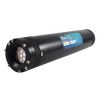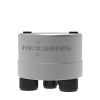Pro-Oceanus Solu-Blu Dissolved CO2 Probe
Features
- Provides continuous 24/7 CO2 monitoring
- Fully temperature and pressure compensated
- User-input salinity values allow for automatic salinity correction
- Expedited repair and warranty service
- Lifetime technical support
- More
Overview
The Pro-Oceanus Solu-Blu dissolved CO2 probe can be used for long-term continuous in-situ monitoring to provide reliable free dissolved carbon dioxide data. The probe provides a fully temperature and pressure compensated free dissolved CO2 and partial pressure of CO2, and user-input salinity values allow for automatic salinity correction. Flow-through and in-line adapters are also available for simple and effective industrial solutions.
Mechanics
Combines rugged design, ease of use and versatility, all in a single sensor package. The measurement of a gas dissolved in a liquid is facilitated by a semi-permeable membrane that allows gases to transfer from water into a gas head space where the measurement is made.
| Sensor Performance | |
|---|---|
| CO2 Measurement Ranges | 0-50 mg/L 0-2000 μatm 0-5000 μatm 0-10,000 μatm *other ranges available |
| Accuracy | |
| CO2 | ± 3% of max range |
| TDGP | ± 0.1% (0-2 bar range) |
| Temperature | ± 0.5º C |
| Equilibration rate (t63): | |
| pCO2 | 4 minutes |
| TDGP | 10 minutes |
| Sensor warm up time | 3 minutes |
| Resolution pCO2 | 0.1% of max range |
| Physical | |
|---|---|
| Length | 20 cm (8 in) 26 cm with connector |
| Diameter | 5 cm (2 in) |
| Weight | 0.28 kg (0.6 lbs) |
| Housing Material | Acetal Plastic |
| Depth Rating | 0 - 50 meters |
| Water Temperature | -2º to 40º C |
| Electrical | |
|---|---|
| Input voltage |
digital: 6-24 VDC |
| Power consumption | 0.45 W (35 mA @ 12 V) |
| Data output | RS-232, ASCII format 0-5 V or 4-20 mA |
| Sample rate | 1 second |
In The News
Three Decades of Research at Acton Lake
A multi-disciplinary team at Miami University, Ohio, has been studying the environmental change at Acton Lake for over three decades. Using three different NexSens buoys over this time, the team has an incredible archive of data that is helping build a picture of Acton’s past, present, and future. Until recently, a NexSens CB-50 buoy was used alongside other environmental monitoring at Acton Lake. In May 2025, the Miami team deployed a new XB-200 buoy , future-proofing their ongoing monitoring using real-time buoy systems. Acton Lake, a small hypereutrophic reservoir in southwest Ohio, covers 2.4km² and has a maximum depth of about 8m. The dam was built in 1956, and the lake has a large agricultural watershed.
Read MoreSource Water Monitoring in Albany, New York: Tracing Water Quality throughout Tributaries
Thousands of US cities pull their drinking water from natural source waters like reservoirs, rivers, and streams, making overall watershed health a key consideration for water providers. In Albany, New York, the Albany Department of Water and Water Supply delivers drinking water to over 100,000 residents as well as monitors and manages the larger drinking water supply watershed. Hannah Doherty, Environmental Specialist at the Albany Department of Water and Water Supply , spends her days working with a small team to monitor the drinking supply and the connected water bodies. Doherty explains, “We’re the first to encounter the water that ends up being the drinking water.
Read MoreWildfire Prevention in the Sierra Nevada Region with the Yuba Watershed Institute
Though recent wildfires have sparked new conversations about wildfire management and response, groups like the Yuba Watershed Institute have been monitoring the forests and water resources of the Sierra Nevada region for decades, managing approximately 5,000 acres of land with the Bureau of Land Management (BLM) and about 7,000 acres in private land partnerships. The goal of the Institute is to work with local communities and land agencies to improve watershed and forestry management through informed practices and public outreach. The goals of the Yuba Watershed Institute are three-fold: Improve the ability of fire suppression agencies like the California Department of Forestry and Fire Protection ( CAL FIRE ) and the US Forest Service.
Read More

















